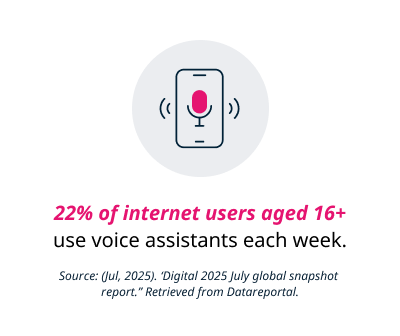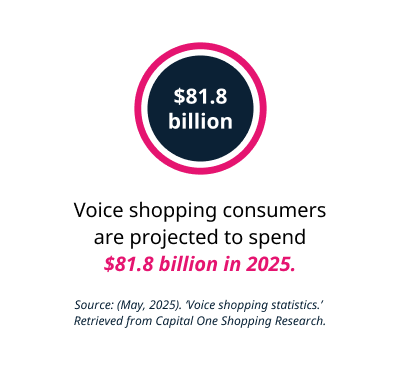Applications of speech recognition
Speech recognition is no longer just for digital assistants; it is a critical technology driving efficiency and major transformation across healthcare, finance, and the modern workplace.
Powered by massive leaps in AI, deep learning, and on-device processing, today’s automatic speech recognition (ASR) systems are faster, more accurate, and more context-aware than ever before. Far from simply converting voice to text, speech AI systems can help shorten your workday, secure your home, and even drive your car.

Key takeaways
- Automatic speech recognition (ASR) uses technology to convert speech into text. Speech AI systems use AI and NLP models to extract insights from this data and make decisions.
- Digital assistants like Siri and Alexa use speech recognition to interpret voice commands and act as agents on users’ behalf.
- Speech recognition technology is used in a variety of industries to improve efficiency, safety, and outcomes. For example, virtual meetings are transcribed and summarized instantly. And while driving, people can use voice commands to monitor their navigation.
What is speech recognition technology?
The umbrella term ‘speech AI’ encompasses several distinct, yet interconnected, technologies, all powered by machine learning to analyze audio data.
Automatic speech recognition (ASR) is the technology that converts spoken words or recorded audio into written text. This is also referred to as ‘speech-to-text.’ ASR’s primary goal is accurate transcription.1
Examples of ASR include:
- Using your smartphone’s dictation feature to record a voice note that is automatically transcribed and sent as a text message.
- A doctor using a dictation system to transcribe patient notes directly into an electronic health record.
- Live captioning on a TV broadcast or online video.
Natural language processing (NLP) is a subset of machine learning in which computers interpret, manipulate, and comprehend human language. Speech recognition is an example of NLP for audio data. There is also text-based NLP that analyzes large corpuses of written information.2
Examples of NLP include:
- A language translation app that converts text from one language to another.
- Automatic grammar and spell-check systems.
- Email filters that automatically detect spam based on the language used and metadata.
Audio intelligence refers to the application of machine learning models to extract insights from audio data and complete tasks like sentiment analysis or content moderation. Audio intelligence relies on automatic speech recognition to convert audio data into digital information and NLP models to complete tasks.3
Examples of audio intelligence include:
- A smart home device detects the sound of a fire alarm or a window breaking to send a security alert to authorities.
- Software that listens to recorded customer service calls and automatically identifies and categorizes the customer’s tone as positive or negative.
What are speech recognition digital assistants?
Digital assistants are designed to help people perform or complete basic tasks and respond to queries. With the ability to access information from vast databases and various digital sources, these robots help to solve problems in real time, enhancing the user experience and human productivity.
Popular digital assistants, include:
- Amazon’s Alexa
- Apple’s Siri
- Google’s Google Assistant
- Microsoft’s Cortana
Five applications of speech recognition technology for 2026
Speech recognition technology and the use of digital assistants quickly moved from mobile phones to homes. Today, its application is apparent across crucial industries, including healthcare, banking, and marketing.
1. Speech recognition in the workplace
Speech recognition technology in the workplace is moving beyond simple voice commands to become a primary engineer for productivity and efficiency. The core goal of this technology in the workplace is the elimination of low-value, repetitive administrative tasks, freeing employees to focus on strategic work.
- Meeting and notetaking automation: AI serves as a virtual meeting scribe for the hybrid work environment. Using ASR technology, platforms can automatically transcribe conversations in real-time, even with multiple speakers or diverse accents. These systems immediately extract insights, generate summaries, and identify next steps or action items to share with participants.4
- Customer service: Speech AI and ASR are leveraged in the customer service industry to augment human work. For example, real-time agent assist features can do live sentiment scoring and summary of customer calls, providing immediate, actionable insights for representatives.5
- Workplace accessibility: Speech recognition is critical for making in-person and hybrid work environments more accessible for all employees. Real-time transcriptions provide support for people with hearing impairments or language barriers.
2. Speech recognition in banking
For the banking and financial services industry, Speech AI can help achieve two main goals: enhancing security and fraud prevention and creating a frictionless customer experience. The technology moves beyond simple account inquiries to handle complex authentication and compliance requirements.
- Personalized self-service: Speech-based tools can allow users to schedule recurring payments, check available funds, and review past transactions over the phone. For example, some bank mobile apps offer users the ability to use their microphone to send money via Zelle or transfer funds.6
- Call routing: Speech AI can interpret live phone calls to immediately route customers to the right bank department or specialist, reducing the need for transfers. This can also lead to shortened resolution times.7
3. Speech recognition in marketing
Speech AI has added a new dimension to how marketers interact with consumers, making search and shopping more conversational and immediate. This shift requires marketers to pivot their digital strategies to focus on how people talk, not just how they type.
- Voice commerce: Shopping via voice command is expected to produce $81.8 billion in sales worldwide in 2025.8 Consumers use voice assistants to research products, check prices, and make purchases. This move towards V-commerce mandates that brands optimize product listings and checkout experiences to work via voice commands.

- Conversational SEO: Voice queries tend to be longer, more conversational, and more question-based than typed queries. Marketers must optimize content for long-tail keywords and answer-focused content.9
4. Speech recognition in healthcare
In healthcare settings — where accuracy, speed, and hands-free operation are matters of patient safety — Speech AI offers transformative potential for clinical efficiency and reducing physician burnout.
- Documentation: Digital scribes use ASR to document provider-patient interactions and then summarize the visit, populate diagnostic fields, and create billing codes. In a study of nurses who used speech recognition systems to record and document nursing reports, researchers found that paperwork reduction, performance improvement, and cost reduction were some of the most common benefits.10

The most significant concern using speech recognition in healthcare is the content the digital assistant or AI platforms can access. Hallucinations, transcription errors, and omissions all pose risks to patient privacy and safety. Proper guardrails and oversight can help mitigate these risks.11
5. Speech recognition and the Internet of Things
Speech recognition is a core component of the Internet of Things (IoT), acting as the interface between interconnected smart devices. This is expanding beyond basic smart home features into complex multimodal systems and large-scale industrial applications.
- Automotive control: In vehicles, Speech AI can help manage navigation, climate control, and infotainment systems. By allowing drivers to interact using natural speech, the technology reduces cognitive load and visual distraction.12 Researchers are also experimenting with ‘hearing cars’ — vehicles equipped with external microphones and AI to help detect and classify hazards that autonomous cars can’t see. Approaching emergency vehicles are the first hazard being tested, but future capabilities could include sensing pedestrians or failing brakes.13
- Multimodal security: The future of IoT is multimodal, combining voice with other inputs like computer vision (for facial recognition) and gesture control. For example, a system can confirm a user’s identity via voice biometrics while simultaneously verifying their face, offering a higher level of security for unlocking doors or authorizing sensitive transactions.
Future applications
The speech and voice recognition market is experiencing an explosion of growth, driven by breakthroughs in AI and the rapid integration of large language models (LLMs). The global conversational AI market alone is projected to reach over $136 billion by 2035.14
The future of speech recognition could include developments in contextual intelligence and multimodal integration.
- Context-aware AI: Autonomous AI agents are systems that can set goals, plan complex tasks, and act with little human intervention. This could mean that instead of waiting for a command, future voice assistants might be able to anticipate user needs. For example, automatically adjusting the vehicle temperature based on a passenger talking about how warm they are.
- Multimodal integration: When Speech AI is integrated with visuals, gestures, and sensor data, it will become more powerful. For example, visual analysis of speakers’ lip movements could help reduce transcription errors. Another example of a future use case is with large-language model (LLMs) applications, like Gemini Live. Users can speak directly to an LLM and have a conversation with the AI system about uploaded files, photos, or a live feed from the phone camera.15
Explore online artificial intelligence courses and machine learning courses to explore speech AI and the models that power these platforms.
- 1 (Nd). ‘What is speech recognition?’ Retrieved from IBM. Accessed on October 11, 2025.
- 2 (Nd). ‘What is natural language processing (NLP)?’ Retrieved from AWS. Accessed on October 11, 2025.
- 3 Foster, K. (Feb, 2022). ‘What is audio intelligence?’ Retrieved from AssemblyAI.
- 4 (Nd). ‘Take notes for me in Google Meet.’ Retrieved from Google. Accessed on October 12, 2025.
- 5 Ng, Aaron. (Jun, 2024). ‘Summaries and sentiment in real-time.’ Retrieved from Speechmatics.
- 6 (Jul, 2020). ‘Introducing the U.S. Bank Smart Assistant.’ Retrieved from U.S. Bank.
- 7 (Apr, 2025). ‘Voice AI in banking: Powered by generative AI and LLMs.’ Retrieved from ServisBOT LinkedIn.
- 8 (May, 2025). ‘Voice shopping statistics.’ Retrieved from Capital One Shopping Research.
- 9 (Apr, 2025). ‘How to optimize for voice search in 2025.’ Retrieved from Circle Studio.
- 10 Dinari, F, et al. (Jun, 2023). ‘Benefits, barriers, and facilitators of using speech recognition technology in nursing documentation and reporting: A cross‐sectional study.’ Retrieved from Health Science Reports.
- 11 Topaz, M, et al. (Sep, 2025). ‘Beyond human ears: navigating the uncharted risks of AI scribes in clinical practice.’ Retrieved from NPJ Digital Medicine.
- 12 (Nd). ‘Use Assistant commands in your car.’ Retrieved from Google. Accessed on October 15, 2025.
- 13 Jones, W. (Sep, 2025). ‘“Hearing car” detects sounds for safer driving.’ Retrieved from IEEE Spectrum.
- 14 (Oct, 2025). ‘Conversational AI market industry trends and global forecasts to 2035.’ Retrieved from Business Wire.
- 15 (Nd). ‘Gemini Live.’ Retrieved from Gemini. Accessed on October 16, 2025.

